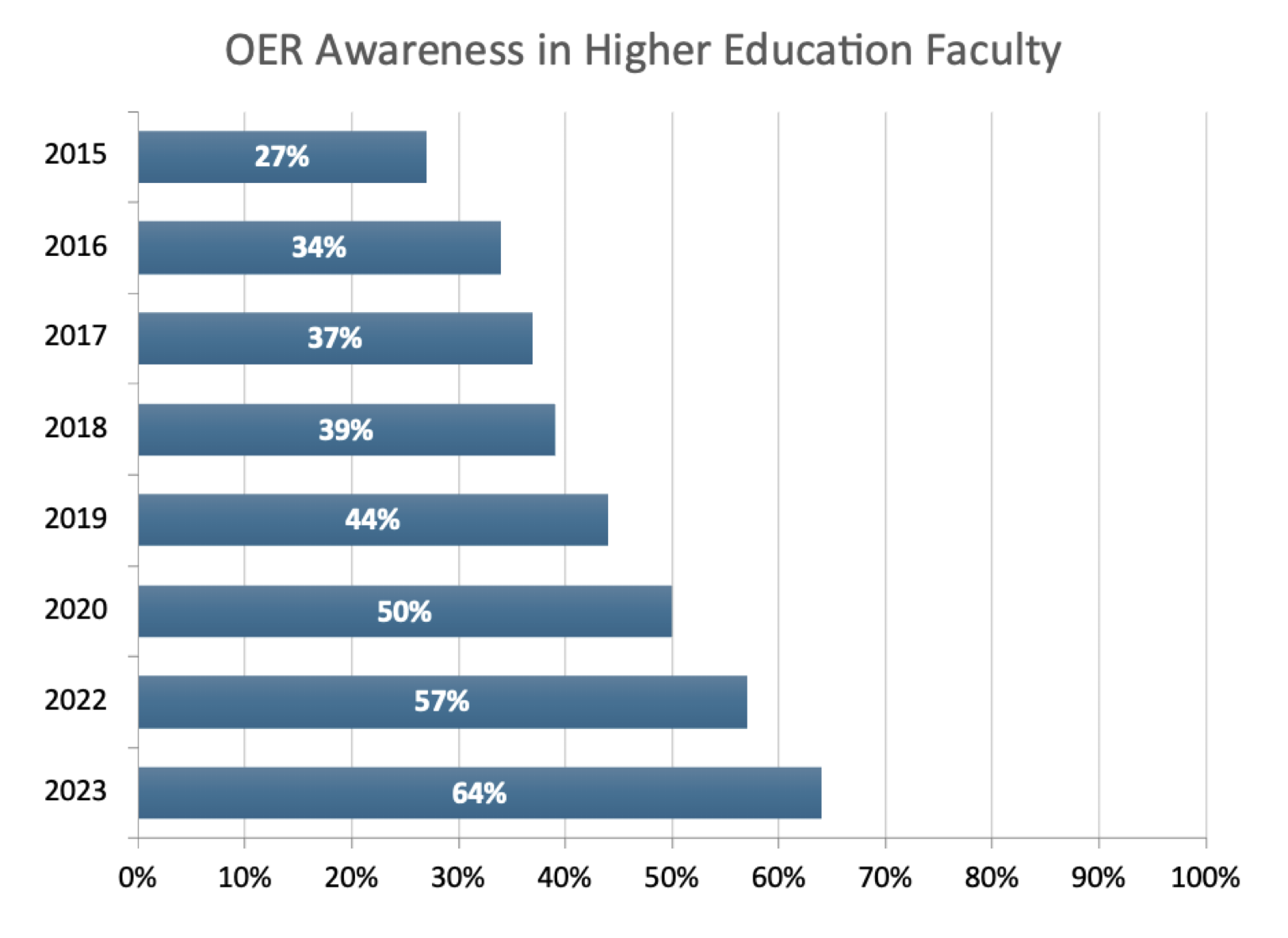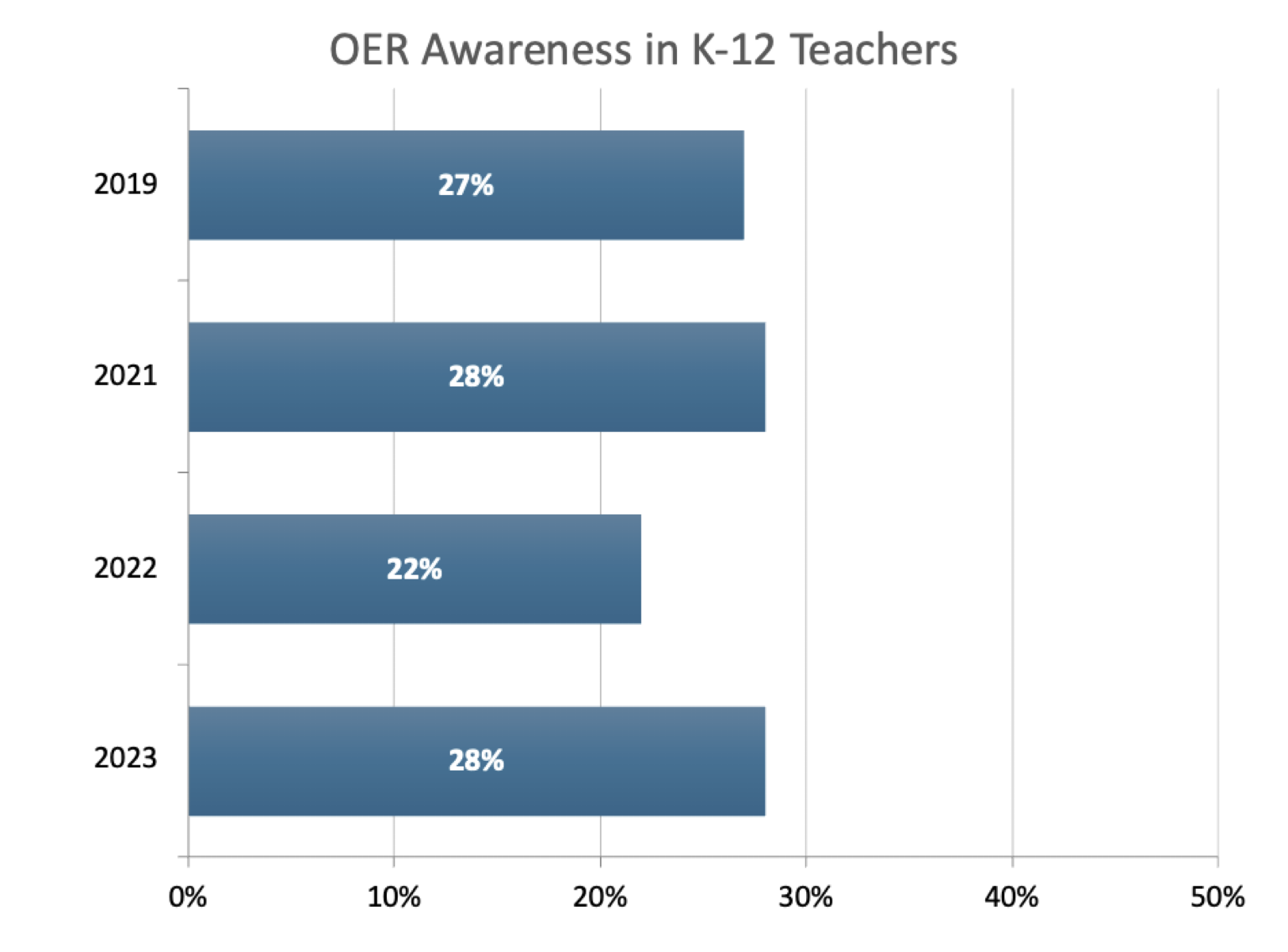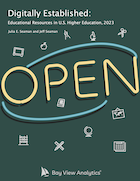Open Educational Reports and Presentations - 2023
Digitally Established: Educational Resources in U.S. Higher Education, 2023
Download Report: Digitally EstablishedNearly two thirds (64%) of U.S. higher education faculty are aware of open educational resources (OER) and nearly one third (29%) require an OER in their course, according to an annual survey of faculty and administrators. Both awareness and use of OER—which are openly licensed and thus free to use, edit, and share—jumped by seven percentage points compared to the 2021-22 school year, reaching their highest levels seen in the 12 years the survey has been administered.
Other key findings include:
• Faculty are most commonly using digital tools, like digital textbooks and homework software, to replace print tools like physical textbooks and homework handouts. But a small number of faculty are also utilizing new tools that have no physical counterpart, such as digital collaboration tools and student progress monitors.
• Faculty are generally satisfied with the overall quality of their curricula, as 50% gave their curricula a grade of either an A or B.
• 62% of faculty agree that the cost of course materials is a serious problem for their students.
• Although reported use of inclusive access programs—also known as automatic purchase programs—remains steady, there appears to be confusion around them, as 51% of faculty said they were not aware of these programs, compared to 44% who said they were unaware in 2021-22.
Curricula of Many Sources: Educational Resources in U.S. K-12, 2023
Download Report: Curricula of Many SourcesMore than three quarters (77%) of K-12 teachers create their own classroom materials to supplement or replace a textbook, and among those who do use a textbook, the same percentage (77%) offer it to their students in digital format, according to the results of an annual survey of K-12 educators and administrators. This gravitation toward self-created and digital materials is complemented by an increasing awareness of open educational resources (OER), which are free to use, edit and share. More than one in four (28%) teachers are now aware of OER and Creative Commons licensing—an uptick of six percentage points compared to the 2021-22 school year.
Other key findings include:
• Textbooks remain a fixture in classroom instruction, as 72% of teachers say they require a textbook in their classrooms.
• Over half of teachers agree that “they prefer print materials over digital for teaching” (57%), and that “students learn better from print materials than they do from digital” (59%). Half of teachers agree that “students prefer print over digital” (50%).
• Many teachers use digital tools in their classrooms on a daily basis. The most commonly used student-facing tools are laptops and tablets, and the most commonly used teacher-facing tools are digital grading and attendance tools.
• While slightly more than half of teachers (51%) give their curriculum a grade of an A or B, only a third of teachers (33%) give their professional development similarly high marks.
Research Brief:
Digital and OER Textbook Adoption
The global COVID-19 pandemic changed how faculty teach, and resulted in a large rise in digital curricula use. We partnered with the Brian Murphy Group to investigate how the digital adoption trend varied across different course disciplines. The study examines selected large-enrollment introductory-level courses for the Fall 2020, Fall 2021, and Fall 2022 terms. The shifts in perspectives on digital learning is part a growing acceptance of digital materials that we've been monitoring for years. During the 2018-2019 academic year, 44% of faculty agreed with the statement "Students learn better form print materials than they do from digital." By the 2021 - 2022 academic year, that figure dropped to 33%. In the same academic year, the majority of faculty and administrators expressed agreement with the statement "Digital materials provide greater flexibility for students." Only a small number disagree with the statement (5% faculty, 4% administrators), with only 1% of faculty strongly disagreeing.
The results show that print textbooks remain a dominant form factor. But the growing demand for digital textbooks speaks to where demand may be heading.
Research Brief:
Faculty Satisfaction with Course Materials varies by Publisher
As part of our research into faculty satisfaction with curricula, we took a look at how satisfaction varies by publisher type, comparing major commercial publishers, smaller commercial publishers, and OER, and measured how OER fares across several factors. The study examines multiple aspects: overall, accuracy, scope of content, included instructor materials, and cost to student.
OER Awareness
Higher Education
Awareness levels are above 50% across all faculty demographic subgroups. There are some demographics that are associated with higher levels of awareness. For example, faculty who have experience teaching online, teaching at 2-year institutions, or teaching at public institutions are all more likely to be aware of OER.

K-12
K-12 teacher also report an increase in OER awareness for the 2022-23 school year. The total level of OER awareness is 28%, returning back to the pre-pandemic level after a small decline last year.While the total level of K-12 teacher OER awareness has remained relatively stable, the proportion of teachers reporting that they are “very aware” has slightly increased this year. Awareness levels grow to over 35% for teachers in high school and those who currently teach partially or fully online this year.

Recent Presentations
USDLA 2023 National Conference
Session Title: Tracking OER Awareness and Adoption in US K-12 and Higher Education — Results from our 2022-23 National SurveyPresentation Time: July 19, 2023, 2:30 - 3:15 PM ET
This presentation reports the latest results from our national surveys tracking the awareness of open educational resources (OER) in US K-12 and higher education classrooms. Since 2009, Bay View Analytics has been tracking the growing awareness and adoption of OER through annual surveys of teachers, faculty, and administrators. The presentation show how OER trends vary by grade level, course discipline, and school demographics.
Download presentation slides
Recent Publications
Course Material Affordability
- 2023 National Course Materials Survey
- Pennsylvania Course Materials Survey 2023
- Pennsylvania Course Materials Presentation
- Course Material Webinar Slides
Open Educational Resources
- Digitally Established: Educational Resources in U.S. Higher Education, 2023
- Curricula of Many Sources: Educational Resources in U.S. K-12, 2023
- Research Brief: Digital and OER Textbook Adoption
- Research Brief: Faculty Satisfaction with Course Materials varies by Publisher
Digital Learning Pulse Surveys
- Infographic: 2023-2024 Digital Learning Pulse Survey
- The Digital Transformation of the Community College
- Planning for a Smaller Future: Dealing with Declining Enrollments
STEM
- Teaching Online: STEM Education in the Time of COVID
- What Makes a STEM Student
- Perceptions of the Future of STEM Education
Distance Education
- Digital Faculty: Faculty Social Media Use and Communications
- Infographic: Digital Faculty
- Grade Increase: Tracking Distance Education in the United States
Follow us on
Privacy
All survey respondents are provided complete anonymity. No personally identifiable information is released. Full privacy policy.



